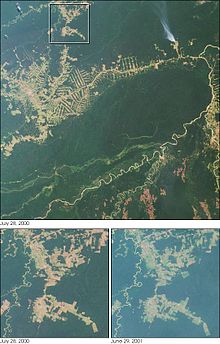 A NASA satellite observation of deforestation near Rio Branco in Brazil, July 2000 | |
| Country | Brazil |
|---|---|
| Location | Amazon basin |
| Forest type | Rainforest |
| Forest area | 2,100,000 sq mi (5,400,000 km2) |
| Main causes | Cattle ranching, logging, climate change, mining, infrastructure development |
Brazil once had the highest deforestation rate in the world and in 2005 still had the largest area of forest removed annually.[1] Since 1970, over 700,000 square kilometres (270,000 sq mi) of the Amazon rainforest have been destroyed. In 2001, the Amazon was approximately 5,400,000 square kilometres (2,100,000 sq mi), which is only 87% of the Amazon's original size.[2] According to official data, about 729,000 km² have already been deforested in the Amazon biome, which corresponds to 17% of the total. 300,000 km² have been deforested in the last 20 years.[3]
Rainforests have decreased in size primarily due to deforestation. Between May 2000 and August 2006, Brazil lost nearly 150,000 square kilometres (58,000 sq mi) of forest, an area larger than Greece. According to the Living Planet Report 2010, deforestation continues at an alarming rate. At the Convention on Biological Diversity's 9th Conference, 67 ministers signed up to help achieve zero net deforestation by 2020.[4] Due to deforestation the Amazon was a net emitter of greenhouse gas in the 2010s.[5]
The effects include "severe financial losses, social setbacks, and biodiversity loss". Economic losses due to deforestation in Brazil could reach around 317 billion dollars per year, approximately 7 times higher in comparison to the cost of all commodities produced through deforestation. In 2023 the World Bank, published a report named: "A Balancing Act for Brazil’s Amazonian States: An Economic Memorandum" proposing non-deforestation based economic program in the region of the Amazon rainforest.[6][7]
- ^ "World deforestation rates and forest cover statistics, 2000-2005". news.mongabay.com. 2005-11-16. Retrieved 15 April 2018.
- ^ Malhi, Y.; J. Timmons Roberts; Richard A. Betts; Timothy J. Killeen; Wenhong Li; Carlos A. Nobre (2009). "Climate Change, Deforestation, and the Fate of the Amazon". Science. 319 (5860): 169–172. CiteSeerX 10.1.1.389.7410. doi:10.1126/science.1146961. PMID 18048654. S2CID 33966731.
- ^ "INPE - Instituto Nacional de Pesquisas Espaciais". www.inpe.br. Retrieved 2022-09-10.
- ^ "Living Planet Report 2010". 2010. Retrieved 23 September 2013.
{{cite journal}}: Cite journal requires|journal=(help) - ^ "Brazilian Amazon released more carbon than it absorbed over past 10 years". The Guardian. 2021-04-30. Retrieved 2021-05-01.
- ^ Cite error: The named reference
TheWorldBankwas invoked but never defined (see the help page). - ^ A Balancing Act for Brazil's Amazonian States An Economic Memorandum. The World Bank. 2023. Retrieved 30 May 2023.